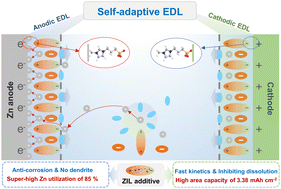Engineering a self-adaptive electric double layer on both electrodes for high-performance zinc metal batteries†
Abstract
Zwitterionic ionic liquids (ZIL) contain covalently bound cationic and anionic moieties with potential electrochemical applications. In this study, we construct a self-adaptive electric double layer (EDL) on the interfaces of the anode and cathode of zinc metal batteries. It is enabled by adding ZIL additives in the electrolyte, which can selectively gather on the electrode surface by the cationic and anionic moieties under the electric field, forming a dynamic electrostatic shielding layer on the Zn anode and a unique water-poor interface on the cathode. In situ characterization and electrochemical studies show that the π–π stacking of the imidazolium cation and sulfonic acid group of the ZIL can timely form a self-adaptive EDL driven by the electric field, which facilitates homogeneous Zn2+ deposition and circumvents the dissolution of the cathode material. Benefiting from the strategy, the Zn//Zn cell enables dendrite-free plating/stripping with a 35-fold enhancement in running lifetime (3500 h) compared to the base electrolyte, and a super-high Zn utilization of 85% at high current densities (10 mA cm−2, 20 mA h cm−2). In addition, the Zn//NaV3O8·1.5H2O full battery shows superfast charging/discharging (3000 cycles at 20 A g−1, a capacity retention of 88% and exhibits an ultra-high-areal-capacity of 3.38 mA h cm−2 (91.15% retention after 540 cycles) with a high-mass-loading cathode (10.16 mg cm−2).



 Please wait while we load your content...
Please wait while we load your content...